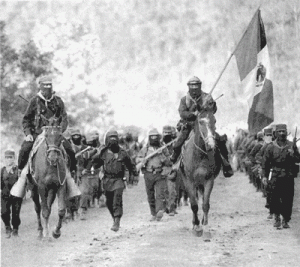Seventeen years ago today, as Mexico’s ruling class celebrated the New Year and the inauguration of an agreement with the USA that they hoped would propel them into the “First World”, more than 3,000 indigenous Mayan Indian guerrillas came down from the mountains of the southern province of Chiapas and declared war against the Mexican government. These guerrillas – representing some of the poorest and most exploited people of the world and armed with everything from AK-47s to sticks – had deliberately chosen New Year’s Day to commence their uprising, for it was the date when the North American Free Trade Agreement (NAFTA) went into effect. This cynical Neoliberal agreement was an opportunity for the Mexican government to intermingle with Corporate America. But for the Indian peasants and farmers, it was their death warrant. NAFTA aggressively promoted corporate privatisation, removed Mexico’s right to review foreign investment proposals, banned subsidies to the indigenous farmers, favoured U.S. imports and, most significantly, required Mexico to alter its constitution by abolishing Article 27 which provided land to those who worked it. Nearly 100 years had passed since the Mexican Revolution had triumphed to return indigenous land through agrarian reform; and although there had subsequently been many broken promises, NAFTA now threatened to take away from the peasant farmers what little was left and hand it over to McDonalds and its earth-raping ilk. And so, with nothing left to lose, the indigenous workers organised – and a new kind of army emerged. The Zapatista National Liberation Army (EZLN) took their name from the legendary Emiliano Zapata, the slain anarchist hero of the 1910 revolution whose army of peasants had risen up against the wealthy landowners. “We are the product of 500 years of struggle,” the Zapatistas decried in their First Declaration from the Lacandon Jungle. “But today we say Ya Basta! Enough is enough!” The Zapatista Uprising revived the Mexican anarchism that had been dormant for years, put a spotlight on the oppression of 20 million indigenous people and represented the first major resistance against the global free-market Neoliberalism that had reigned un-policed in the wake of the collapse of the Soviet Union in 1991. The uprising would also launch a modern revolutionary hero: the mysterious masked man known only as Subcomandante Marcos. A tall, pipe-smoking romantic figure, Marcos evoked Che Guevara with his eloquent criticisms of global capitalism and the corrupt Mexican government. But it was his canny utilisation of the music and technology of the Internet era that ensured the whole world was watching the Zapatistas. As the New York Times said of this uprising that captured the imagination of freethinkers, activists and anti-capitalists everywhere: “It was the world’s first post-modern revolution.”
For two days, the Zapatistas seized control of the city of San Cristóbal de las Casas and several surrounding towns in Chiapas – the Mexican state richest in natural resources but poorest in income and social services. The attack was met by a heavy-handed response from the US-backed Mexican Army, resulting in the death of some 150 guerrillas. But the enormous international support for the Zapatistas was an embarrassment to the administration of President Carlos Salinas, who was forced to call off the assault when hundreds of thousands of Mexicans flooded into the central government square in Mexico City to show their solidarity with the Zapatistas. Following negotiations mediated by Bishop Samuel Ruiz – a long-time defender of the peasants in his Chiapan diocese – an uneasy ceasefire was called, and the Zapatistas retreated ever deeper into the jungle. Despite the overly-rigorous efforts of the Mexican military and the sadistic government-backed paramilitary (paradoxically called “Peace & Justice”) to quash the Zapatistas, the EZLN has survived to continue its non-violent struggle to focus the world’s attention on the plight of Mexico’s Indians and peasants through its ongoing negotiations with the Mexican government and ingenious campaigns and communiqués. Since 1994, the Zapatistas have emerged as a significant political force and have gradually formed several autonomous municipalities independent of the Mexican government. The righteousness of their words, deeds and cause is both an inspiration and evidence of the validity of revolutionary action against the nefarious forces of capitalism. It is a movement in which women had and have a decisive role in its conception and realisation (the “Women’s Revolutionary Law” was a pivotal adjunct of the First Declaration). And it is a movement expressly designed to emblemise the world’s oppressed. Marcos wears his mask not only to protect his identity but insists it is also a mirror. In his own words: “Marcos is gay in San Francisco, black in South Africa, an Asian in Europe, a Chicano in San Ysidro, an anarchist in Spain, a Palestinian in Israel, a Mayan Indian in the streets of San Cristobal, a Jew in Germany, a Gypsy in Poland, a Mohawk in Quebec, a pacifist in Bosnia, a single woman on the Metro at 10pm, a peasant without land, a gang member in the slums, an unemployed worker, an unhappy student and, of course, a Zapatista in the mountains.”
Just as JFK declared his solidarity not only to West Germans but to freedom-lovers everywhere when he famously said “Ich bin ein Berliner” – as Subcomandante Marcos would have it, all opponents of Neoliberalism are Zapatistas. And so to Zapatistas everywhere – but especially to the brave men and women of the EZLN in Chiapas – a very Happy New Year. Hasta la Victoria Siempre!


No comments:
Post a Comment